#Women Cartoonists of the Jazz Age
Explore tagged Tumblr posts
Text
Comics Read 02/10-03/31/2024
Over this period of time I read a special compilation called The Flapper Queens, Women Cartoonists of the Jazz Age. The compilation is in this beautiful hard cover volume. It was edited and compiled by Trina Robbins and I have been meaning to look into more of her work ever since I learned that she created the costume design for Vampirella. (I am sad to say that between starting to draft this and posting it Robbins died.) While reading this didn’t do much to better acquaint myself Robbins’ work it was interesting and a mostly enjoyable to read collection. The cartoonist that this volume focuses on are: Nell Brinkley, Eleanor Schorer, Edith Stevens, Ethel Hays, Fay King and Virginia Huget. I have not idea if anyone else should have been included. Not all of the cartoons were great, and the standard warnings about the racism and sexism of the times needs to be applied. Still the drawings were often very pretty and the situations depicted were a fascinating time capsule. If I wrote this in a more timely manner I might have written more about it presenting a view of how flappers were perceived in their time, but not really what it was like to be one, leading me to wonder who the target audience was… but I didn’t write this in a timely manner and now I have to write about two more comics that I read.

The first is Girl written by Peter Milligan with art by Duncan Fegredo and colors by Nathan Eyring. I know Milligan is controversial, brining up tricky topics in not the most sensitive ways, or ways that become quickly out of political. But I mostly like him as a writer. I think he can get to a sublime sense I don’t get from many writers. He and Fegredo did that with their earlier comic Enigma. That said, I didn’t like Girl that much. The grim set up felt too heavy, the potentially delusional narrator too sad. It may have started with some interesting ideas, but it did not really pull them off. The too happy ending was neither earned nor unsettlingly unreal. I wanted it to be real because the misery earlier was too much, but mostly it made the story feel pointless. I didn’t love the art. This was originally published in 1996 and some of it is that style just isn’t to my taste these days. Though I have to appreciate how the artist worked to make two characters identical except the hair and clothes.
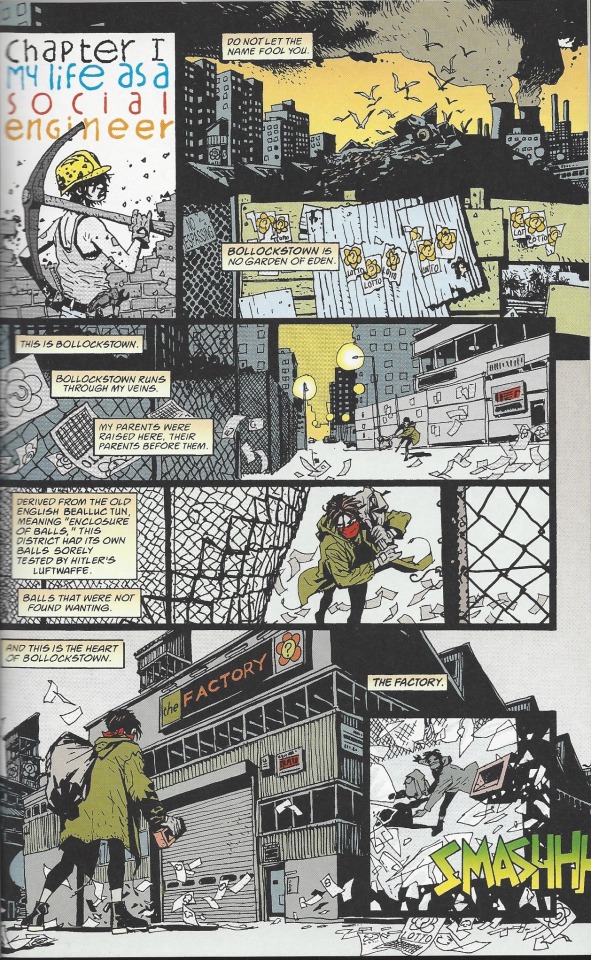
Finally I read the miniseries Afterlift. I bought it because it was written by Chip Zdarsky, artist for Sex Criminals and writer for the Kaptara, (which, much to my surprise has a second volume coming out this week) as well as some Big Two titles that I don’t read. The art is by co-creator Jason Loo, with colors by Paris Alleyne, Letters by Aditya Bidikar, and edited by Allison O’Toole. This was a refreshing read. It is the story of a ride share driver named Janice Chen who unknowingly picks up a demon planning to escort a miserable soul to Hell. It’s funny, it cares about the state of the soul, it’s not too attached to any specific dogma. The art is fun, easy to read, filled with distinct, both human and divine. The colors are great at evoking different dark scenarios while still being clear. A good reminder of why I sill make time to read comic books.
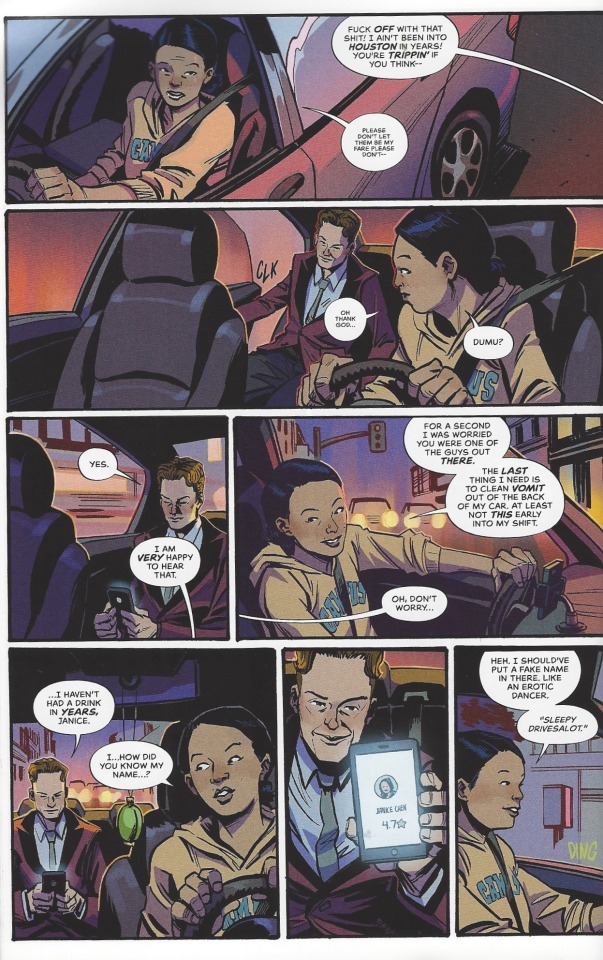
#comic books#what i'm reading#The Flapper Queens#Women Cartoonists of the Jazz Age#trina robbins#Nell Brinkley#Eleanor Schorer#Edith Stevens#Ethel Hays#Fay King#Virginia Huget#Girl#Vertigo comics#dc black label#peter milligan#Duncan Fegredo#Nathan Eyring#Afterlift#chip zdarsky#jason loo#paris alleyne#aditya bidikar#Allison O’Toole
1 note
·
View note
Text



“We Moderns”, a 1928 Ethel Hays cartoon about the Art Deco fascination with geometric shapes, featured in the late Trina Robbins book, “The Flapper Queens: Women Cartoonists of the Jazz Age”, published by Fantagraphics in 2020 | https://amzn.to/3LyoAFC
Book Description “From the foremost historian of women cartoonists, Trina Robbins, comes an eye-catching collection of comic strips from the Roaring Twenties depicting the high-stepping “Flapper” — the symbol of women’s newfound freedom — all drawn by the best female cartoonists of the era! Including Nell Brinkley, Ethel Hays, Eleanor Schorer, Edith Stevens — and possibly the flappiest of the Flapper Queens, Virginia Huget! This collection not only brings back into the spotlight several legendary women artists obscured by the sands of time but also celebrates an unabashedly feminist movement in our nation’s history.”
10 notes
·
View notes
Text

Of all the cartoonists whose work appears in Trina Robbins’s brilliant book, The Flapper Queens: Women Cartoonists of the Jazz Age, my favourite is Fay King. Like her dazzling contemporaries, King used her strips to review movies and plays, as well as to chart the latest fashions. But she’s at her best – and her most modern – when her material is autobiographical. “The ukulele has not made me as popular as I expected,” she writes, in a cartoon depicting herself, all 45-degree angles and shingled hair, learning new instruments. “Women now read newspapers,” she observes tartly, in one of several strips in which her feminism is explicit. And then there’s her intriguingly hectic private life. In 1913, King caused a stir when, having married boxer Battling Nelson, she filed for divorce only a month later, claiming that he had kidnapped her and forced her to get hitched.
But in truth, every page of this luscious collection is delightful. Quietly curated by Robbins, an Eisner award-winning comics historian – she’d rather showcase her subjects’ work than spout social history – it begins with the most famous flapper cartoonist of them all, Nell Brinkley, who in 1925 began working on the first of her beautifully illustrated serials starring several somewhat daffy females: The Adventures of Prudence Prim; The Fortunes of Flossie; Dimples’ Day Dreams (in which the heroine fantasises, among other things, about running for president). Brinkley was wildly influential, “the most copied artist in the world”, according to some.
She was not alone. At the Boston Post, Edith Stevens was drawing a daily strip, Us Girls, devoted largely to fashion (“For winter, stockings with larger open mesh than ever,” she writes, gently poking fun at the latest torture device for the modish female), while Ethel Hays, whose career began at the Cleveland Press, turned her attention to all manner of modern problems, from the best way to cover one’s bathing suit (“the water is so concealing”) to the trouble with marriage (“Brides beware!” she warns her readers. “Don’t expect a Chesterfield. Be content with a human being.”).
I’m mad about this book. If it isn’t cartoon bliss, I don’t know what is – though sadly there’ll be no chortling on the bus: it’s too big to slip into your bag. Robbins wasn't certain where the word flapper originated. It could refer to the movements involved in dancing the charleston, though her preferred theory arises from the fashion in the 1920s for leaving your galoshes unfastened, which meant that they flapped as you walked. But what Robbins understood was that these six American women (the others are Eleanor Schorer and Virginia Huget) represent a revolution, not only in hairstyles and hemlines, but in a woman’s autonomy. They were working girls. The sharp elbows and pointy knees they gave their heroines not only made them look good in short, sleeveless dresses; they spoke, too, of a certain energy: a restless desire to be something more than just a fashion plate, a wife, a mother.
✔ The Flapper Queens edited by Trina Robbins is published by Fantagraphics
Daily inspiration. Discover more photos at Just for Books…?
5 notes
·
View notes
Text
The Flapper Queens: Women Cartoonists of the Jazz Age
Trina Robbins, famosa fumettista e studiosa del fumetto, ha presentato in questo volume le fumettiste dell’era del Jazz! – http://www.afnews.info segnala: Fantagraphics celebra The Flapper Queens, una splendida raccolta di fumetti a colori. Oltre a presentare le più note fumettiste dell’epoca, come Ethel Hays, Nell Brinkley e Virginia Huget, Trina Robbins, vincitrice del premio Eisner, vi…
0 notes
Text
Nell Brinkley and the placement of the vanishing point
I was looking through an online edition (through my library) of The Flapper Queens: Women Cartoonists of the Jazz Age curated by the incredible Trina Robbins. It’s a wonderful collection. I was really struck by the art of Nell Brinkley. Not so much her figures and faces, but her composition and use of color. Then I noticed this opening panel to her Sunday strip, “Sunny Sue.” The vanishing point…
0 notes
Photo

Ethel Hays (March 13, 1892 - March 1989)
From The Flapper Queens: Women Cartoonists of the Jazz Age writen by Trina Robbins, 2020.
156 notes
·
View notes
Text
Notable Books: The Flapper Queens: Women Cartoonists in the Jazz Age
Notable Books: The Flapper Queens: Women Cartoonists in the Jazz Age
Ethen Hays, 1928 Trina Robbins is an under appreciated national treasure. Alas for some of the same reasons the cartoonists she presents here have been overlooked by too many comics histories. For the most part, cartooning was a man’s game in the 20th Century and so has been the writing of its history. Except for Trina. Robbins was among the only female artists in an underground comics movement…

View On WordPress
15 notes
·
View notes
Text

Congratulations to Trina Robbins on her Eisner win for The Flapper Queens: Women Cartoonists of the Jazz Age in the Best Archival Collection/Project - Strips category.
19 notes
·
View notes
Photo

Today we remember the passing of Harvey Pekar who Died: July 12, 2010 in Cleveland Heights, Ohio
Harvey Lawrence Pekar (October 8, 1939 – July 12, 2010) was an American underground comic book writer, music critic, and media personality, best known for his autobiographical American Splendor comic series. In 2003, the series inspired a well-received film adaptation of the same name.
Frequently described as the "poet laureate of Cleveland", Pekar "helped change the appreciation for, and perceptions of, the graphic novel, the drawn memoir, the autobiographical comic narrative." Pekar described his work as "autobiography written as it's happening. The theme is about staying alive, getting a job, finding a mate, having a place to live, finding a creative outlet. Life is a war of attrition. You have to stay active on all fronts. It's one thing after another. I've tried to control a chaotic universe. And it's a losing battle. But I can't let go. I've tried, but I can't."
Among the awards given to Pekar for his work were the Inkpot Award, the American Book Award, a Harvey Award, and his posthumous induction into the Eisner Award Hall of Fame.
Harvey Pekar and his younger brother Allen were born in Cleveland, Ohio, to a Jewish family. Their parents were Saul and Dora Pekar, immigrants from Bialystok, Poland. Saul Pekar was a Talmudic scholar who owned a grocery store on Kinsman Avenue, with the family living above the store. Although Pekar said he wasn't close to his parents due to their dissimilar backgrounds and because they worked all the time, he still "marveled at how devoted they were to each other. They had so much love and admiration for one another."
Pekar said he did not have friends for the first few years of his life. The neighborhood he lived in had once been all white but became mostly black by the 1940s. One of the only white kids still living there, Pekar was often beaten up. He later believed this instilled in him "a profound sense of inferiority." This experience, however, also taught him to become a "respected street scrapper."
Pekar graduated from Shaker Heights High School in 1957. He then briefly served in the United States Navy. After being discharged he attended Case Western Reserve University, where he dropped out after a year. He worked odd jobs before he was hired as file clerk at the Veterans Administration Hospital in 1965. He held this job after becoming famous, refusing all promotions, until he retired in 2001.
Pekar's friendship with Robert Crumb led to the creation of the self-published, autobiographical comic book series American Splendor. Crumb and Pekar became friends through their mutual love of jazz records. It took Pekar a decade to do so: "I theorized for maybe ten years about doing comics." Pekar's influences from the literary world included James Joyce, Arthur Miller, George Ade, Henry Roth, and Daniel Fuchs.
Around 1972, Pekar laid out some stories with crude stick figures and showed them to Crumb and another artist, Robert Armstrong. Impressed, they both offered to illustrate. Pekar & Crumb's one-pager "Crazy Ed" was published as the back cover of Crumb's The People's Comics (Golden Gate Publishing Company, 1972), becoming Pekar's first published work of comics. Including "Crazy Ed" and before the publication of American Splendor #1, Pekar wrote a number of other comic stories that were published in a variety of outlets.
The first issue of Pekar's self-published American Splendor series appeared in May 1976, with stories illustrated by Crumb, Dumm, Budgett, and Brian Bram. Applying the "brutally frank autobiographical style of Henry Miller," American Splendor documented Pekar's daily life in the aging neighborhoods of his native Cleveland.
Pekar and his work came to greater prominence in 1986 when Doubleday collected much of the material from the first ten issues in American Splendor: The Life and Times of Harvey Pekar, which was positively reviewed by, among others, The New York Times. (1986 was also the year Pekar began appearing on Late Night with David Letterman.)
Pekar self-published 15 issues of American Splendor from 1976 to 1991 (issue #16 was co-published with Tundra Publishing). Dark Horse Comics took on the publishing and distribution of Pekar's comics from 1993 to 2003.
In 2006, Pekar released a four-issue American Splendor miniseries through the DC Comics imprint Vertigo. This was collected in the American Splendor: Another Day paperback. In 2008 Vertigo released a second four-issue "season" of American Splendor that was later collected in the American Splendor: Another Dollar paperback.
Pekar's best-known and longest-running collaborators include Crumb, Dumm, Budgett, Spain Rodriguez, Joe Zabel, Gerry Shamray, Frank Stack, Mark Zingarelli, and Joe Sacco. In the 2000s, he teamed regularly with artists Dean Haspiel and Josh Neufeld. Other cartoonists who worked with him include Jim Woodring, Chester Brown, Alison Bechdel, Gilbert Hernandez, Eddie Campbell, David Collier, Drew Friedman, Ho Che Anderson, Rick Geary, Ed Piskor, Hunt Emerson, Bob Fingerman, and Alex Wald; as well as such non-traditional illustrators as Pekar's wife, Joyce Brabner, and comics writer Alan Moore.
In addition to his autobiographical work on American Splendor, Pekar wrote a number of biographies. The first of these, American Splendor: Unsung Hero (Dark Horse Comics, 2003), illustrated by David Collier, documented the Vietnam War experience of Robert McNeill, one of Pekar's African-American coworkers at Cleveland's VA hospital.
Shortly before 1 a.m. on July 12, 2010, Pekar's wife found Pekar dead in their Cleveland Heights, Ohio, home. No immediate cause was determined. In October the Cuyahoga County coroner's office ruled it was an accidental overdose of antidepressants fluoxetine and bupropion. Pekar had been diagnosed with cancer for the third time and was about to undergo treatment.
Pekar was interred at Lake View Cemetery in Cleveland. His headstone features one of his quotations as an epitaph: "Life is about women, gigs, an' bein' creative."
3 notes
·
View notes
Photo









women who inspire me ~ through the ages
Margaret Atwood (1939) - a Canadian poet, novelist, literary critic, essayist, inventor, teacher, and environmental activist. Author of ‘The Handmaid’s Tale’.
Marjane Satrapi (1969) - Iranian-born French graphic novelist, cartoonist, illustrator, film director, and children's book author. Author of ‘Persepolis’.
Joni Mitchell (1943) - Canadian singer-songwriter. Drawing from folk, pop, rock, and jazz. She writes songs that reflect social and environmental ideals.
Chloé Zhao (1982) - Chinese director, screenwriter, and producer. Her first film, Songs My Brothers Taught Me, premiered at Sundance Film Festival in 2018.
Frida Kahlo (1907) - Mexican artist, best known for her self-portraits. Her art explored themes of postcolonialism, gender, class, and race in Mexican society.
Simone De Beauvoir (1908) - French writer, existentialist, activist, feminist, and philosopher. She had a massive influence on feminist existentialism and theory.
Jennifer Lewis (1957) - American actress, singer and activist suffering from bipolar disorder. She is widely regarded as the ‘mother of black hollywood’.
Emma Gonzalez (1999) - American activist, she survived the 2018 Parkland school shooting and founded Never Again MSD, a gun-control advocacy group.
#inspirational women#inspiring women#women#historic women#women in history#amazing women#marjane satrapi#persepolis#lupita nyong'o#black panther#us#star wars#margaret atwood#emma gonzalez#march for our lives#never again#never again ms#msd#school shooting#joni mitchell#simone de beauvoir#fridakahlo#frida kahlo#jennifer lewis#chloe zh#chloé zhao#director#artist#musicians#broadway
57 notes
·
View notes
Video
Life Magazine - 1928-09-28 - Cover art by Russell Patterson by Jim
Russell Patterson (December 26, 1893 – March 17, 1977) was a celebrated and prolific American cartoonist, illustrator and scenic designer. Patterson’s art deco magazine illustrations helped develop and promote the idea of the 1920s and 1930s fashion style known as the flapper.
Russell H. Patterson was born in Omaha, Nebraska. Although he claimed he knew at age 17 that he wanted to be a magazine cover artist, he took a circuitous route to his ultimate success in that field.
In 1925, having arrived in New York City, Patterson suddenly found his direction. He put aside his fine arts ambitions and turned his talents toward illustration. Drawing on his experience sketching beautiful women in Paris, he began adorning covers and interiors for magazines like College Humor and Judge, and later Life and Ballyhoo with his vivacious flappers. Within a couple of years, Russell Patterson the illustrator went from obscurity to celebrity, at a time when the leading graphic artists were as famous as movie stars. As his career blossomed, his ubiquitous version of the modern Jazz Age woman graced the covers and interior pages of The Saturday Evening Post, Vogue, Vanity Fair, Cosmopolitan, Redbook and Photoplay, among many other magazines. As celebrated at that time as the "Gibson Girl" had been years before, his "Patterson Girl" was, in the words of Armando Mendez, "simultaneously brazen and innocent." By incorporating the day's faddish "raccoon coats and flapping, unbuckled galoshes in his drawings, Patterson became a pacemaker in setting styles." Women of the time turned to Patterson's work to follow trends in clothing, jewelry and cosmetics.
-From Wikipedia, the free encyclopedia. This work is licensed under a Creative Commons Attribution-ShareAlike 3.0 Unported License.
#kocojim#news#Russell Patterson#Fashion#cover#illustration#cover art#magazine#art#United States#US#1920s
14 notes
·
View notes
Photo

Nell Brinkley (Sep. 5, 1886 - October 21, 1944)
From The Flapper Queens: Women Cartoonists of the Jazz Age written by Trina Robbins, 2020.
54 notes
·
View notes
Photo

"It runs on nothing but dreams and jazz music. Love too..."
The best time of the year is finally upon us! Yup, talking about Halloween, which I celebrate by packing every single available moment with scary movies. Also, scary video games. Alas, because I’m not much of a PC person (yet), I haven’t had a chance to play FAITH…




Yet I am a total fanboy of the PS2, hence why I’ve expressed my fondness for Haunting Ground quite a few times already…

I’m also quite familiar with Simple 2000 Series Vol. 113: The Tairyou Jigoku...
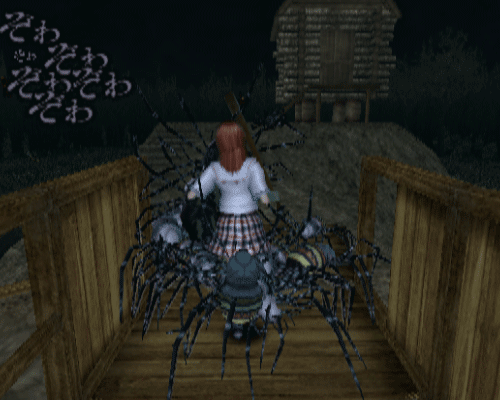
BTW, though last two are courtesy of obscurevideogames, which has been posting gifs from various obscure video games indeed, which also happen to be horror related all month long. Like Twilight Syndrome: Saikai/Reunion, a title I’ve yet to experience, despite being a total fanboy of the PSone as well...

Late to the party I know, but I only just became acquainted with Mason Lindroth and basically want him to do the graphics for all the games...




Something that’s somewhat along the same lines, kinda/sorta, is Middens (via koldspaghetti)...




Remember Gacha Man, one of SPLENDID LAND’s hand crafted robot masters? Guess what; the collection is finally complete…

My fave would have to be (and not just because he reminds of Soundwave) SLN-014 Cassette Man: “by playing different music tapes, his abilities change. he mostly listens to the same few songs over and over though”...

I also dig the redesign of Mega Man himself…

If Splatoon was on the GBA, this is what it would look like, according to suzi-hhh...


It’s somewhat old news, and to be honest, I’m not exactly blown away by them, but for those who missed it and might be interested, behold a Super Famicom Mini-tie in shirt from the King of Games...


The love for the Super Fami is very strong in Japan, and miki800 recently posted a roundup of various goods. With the most interesting being what appears to be a book…


… Which as it turns out is just a blank notebook. But hey, that means you finally have something to write high scores into, given that all the instruction manuals are digital! Never mind the save function on the Super Fami Mini/SNES Classic.
miki800 also recently visited an insanely super awesome looking store. My fave bits would have to be the bootleg AM2 hat…

The Super Girl Boy shirt…
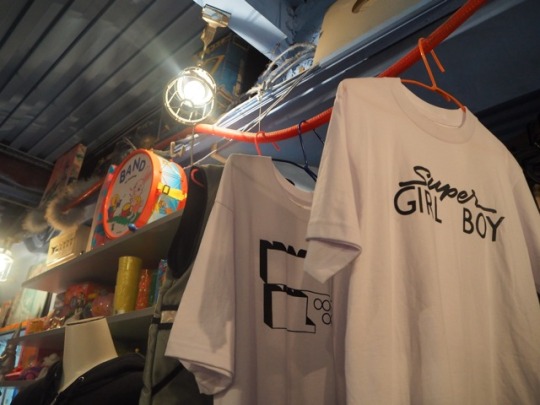
The handmade Space Invader…

And this off brand Lego set (I wonder what that particular Soundwave toy is all about)...

Speaking of threads, I have a new fave Tumblr that’s simply calls itself Video Game Jackets. Here we have Naoto Ohshima’s Sonic Jacket...


Then there’s this Darius jacket…
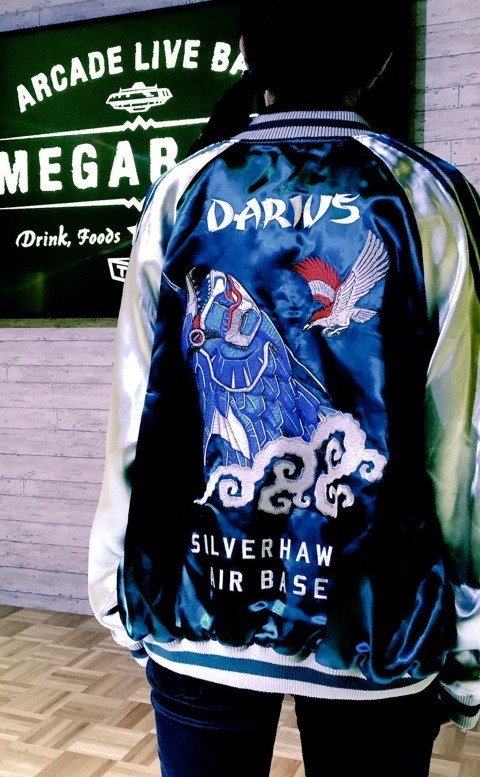
… which is available at Taito’s just opened barcade, MEGARAGE.
And speaking of large fish, arcadephile has a pic of Stephen Spielberg and an arcade game that’s not officially based on Jaws though its source of inspiration is unmistakable...

Mysterious0bob has this noteworthy observation when it comes to Cuphead...
“So everyone knows about the Gunstar Heroes references in Cuphead but I can’t help but feel this boss is a reference to The Adventures of Batman & Robin on the Sega Mega Drive. Its at very least a huge coincidence.
It's not too clear in these screenshots but they have the exact same method of attacking as well (minus the summoning of ghost mice).“
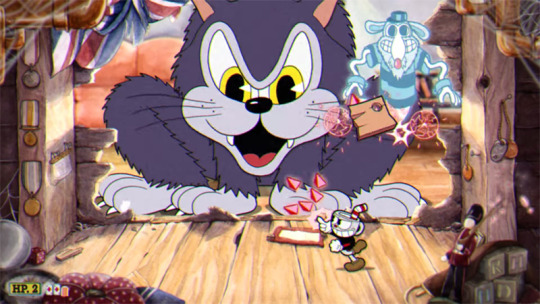
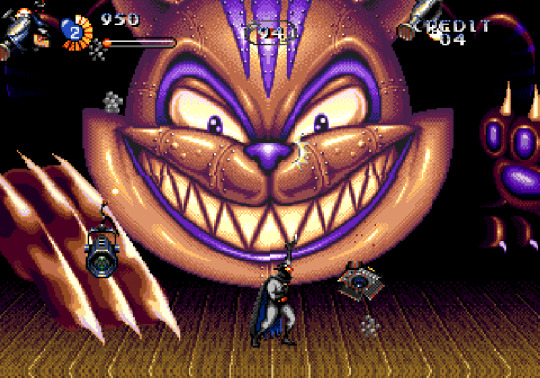
... BTW, I chose a different, higher quality image for Batman & Robin (hope Mysterious0bob doesn’t mind).
Please enjoy this very nice Nier sketch, by Mira Ong Chua…

Along with some Nier… school fashion? By @cyocyo_tasaka, via aku-no-homu…
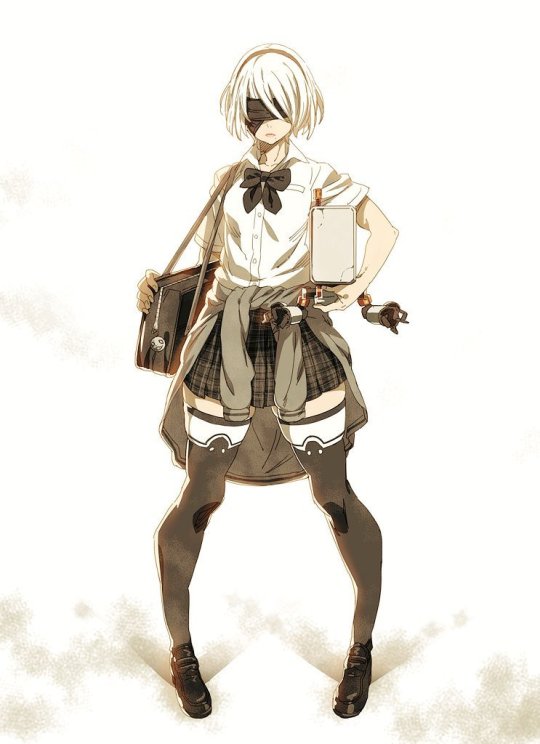


And here’s a nice Metal Gear Solid fan art, by Justin Currie, via gamefreaksnz…

An illustration by Danny Hellman for New York Press from back in the day (it, along with Screw, basically kept local cartoonists afloat during the late 80s to early 2000s), depicting the infamous first release from Ice T’s hardcore band Body Count (which was also the first CD I ever purchased)...

I guess this is a loosely translated Metroid 4koma... or is it poorly (via tabletorgy-art)?

You know how horrible the Secret of Mana remake looks? Whomever should just get the person who did this re-imagining of Chrono Trigger...
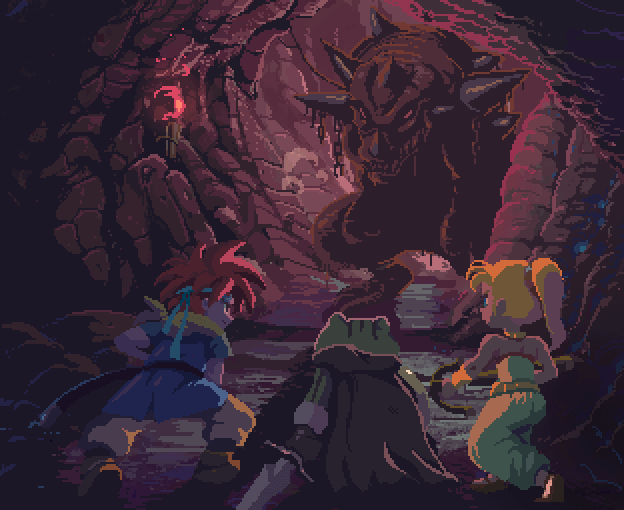
Also thanks to arcade-crusade, I now really want a clear DS...

Am not entirely sure what I’m seeing here; a Game Gear running MSX games (via sixteen-bit)?


doctorbutler wonders who did this Street Fighter x Beavis & Butthead mash-up and I too would like to know!
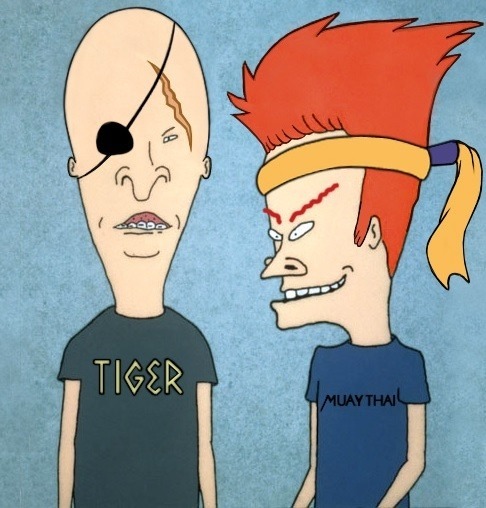
Though the identity of the artist responsible for arguably be the most famous SF2 illustration is well known: Kinu Nishimura. And here’s the WIP version, via videogamesdensetsu...

Sticking with VGD for a sec; say hello to the women of Renai Kōza Real Age...
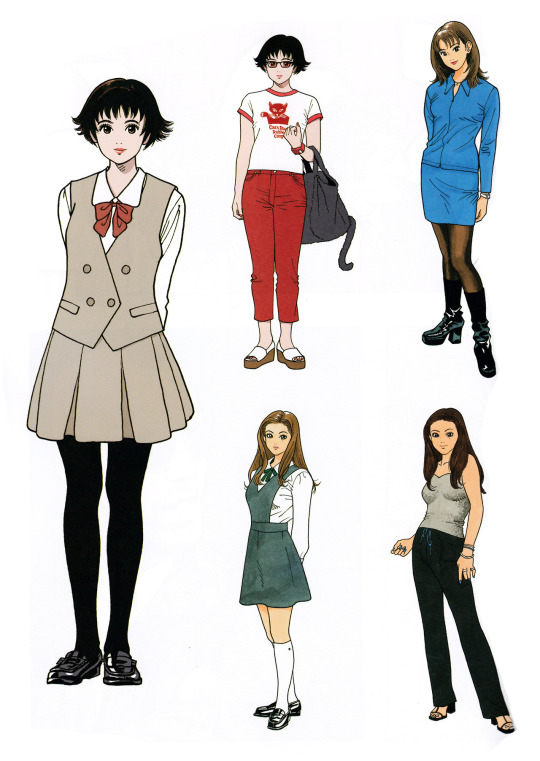

I also respect any game that has the guts to not bother putting the title on its cover…

From 2D to 3D, here we have the evolution of the Virtua Fighters...
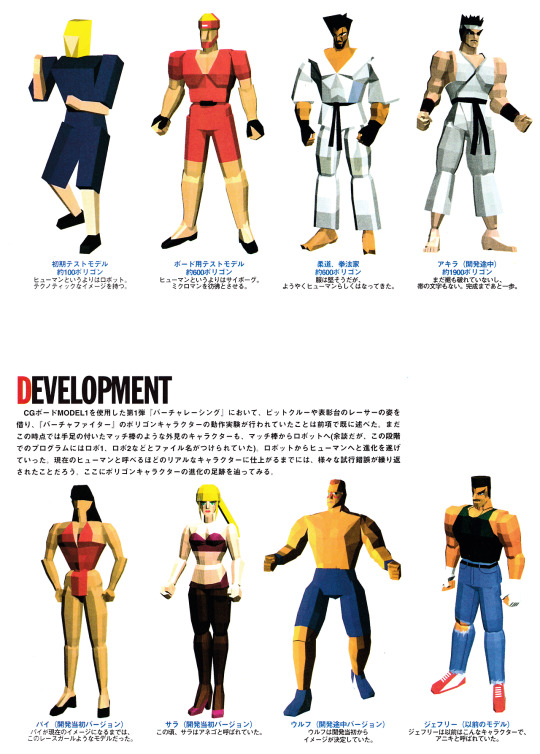
Again, this will be old news to some, but for everyone else, it was recently discovered what Yoshi originally looked like in Super Mario World…

There's apparently a dedicated tool that's just for watching the pre-rendered backgrounds in Silpheed?

And sticking with shmups, ship designs for the rather obscure (and super ambitious) Philosoma…


Any opportunity to post Vic Viper fan art is one I am all too happy to utilize...

Also via the Tumblr that lives up to its namesake is some laserdisc based title starring a ship that I am absolutely in love with...

Here’s the back, btw…

And here’s a rather mysterious flyer…

Equally cryptic is this… I honestly don’t know (via strawberrytabasco)....

[UPDATE: 10/15/17] The mystery has been solved, courtesy of mendelpalace...
“Yo! Just wanted to tell you that the "Blipverts" image from that post you made is related to Max Headroom, a cyberpunk TV show from the 80s. The first episode was called Blipverts, and dealt a TV station making high speed commercials condensed into a few seconds, which have a side effect of making some people's heads explode.”
Heading towards the left is what appears to be a Japanese high school student being followed by what appears to be a ghost in what appears to be a Game Boy Color game (via corporalsteiner)...
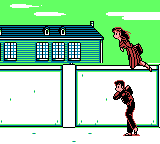
[UPDATE: 10/16/17] Actually, according to lunaticobscurity...
“that's no ghost, it's lum from the early 80s anime urusei yatsura!“.
And heading towards the right is quite obviously the dude from Altered Beast, corrupted (via corruptionasart)...

Time for another animated gif featuring a giant spider, but also time for another animated gif from Sin & Punishment (via n64thstreet)…

It’s also time, especially since it's been a while, for some video games x cats (via tokkeki)...

Time to wrap things up with a scary story, since again, tis the Halloween season. And the following is a truly horrific tale, one that will send chills down the spines of anyone… who is into preserving old arcade cabinets…

Though the spirits of the past remain with us nevertheless… in the form of cheesy store displays (via arcadezen)...

Don’t forget: Attract Mode is now on Medium! There you can subscribe to keep up to date, as well as enjoy some “best of” content you might have missed the first time around, plus be spared of the technical issues that’s starting to overtake Tumblr.
25 notes
·
View notes
Text
"Han sido olvidados": los grandes dibujantes desconocidos | Libros
TEl mundo del cómic, tanto en la página como fuera de línea, es uno que generalmente está dominado por los hombres. Es una brecha de género inevitable, pero lo que aparece a menudo oculta una multitud de talentos femeninos pasados por alto.
Women in Comics: Looking Forward and Back es una exposición colectiva en la Society of Illustrators con más de 50 dibujantes, desde pioneros de principios del siglo XX hasta grandes superhéroes, novelas gráficas queer, romances de guerra y dibujos animados de la era de las aletas, todo lo cual sale de tu típico formato de superhéroe.
"Creo que hay muchas voces y la gente quiere escuchar esta diversidad", dijo Kim Munson, co-curadora de la exposición. "Espero que esto continúe".
La exposición se divide en dos secciones: la historia de las mujeres dibujantes, que datan de principios del siglo XX, y los cómics contemporáneos desde la década de 1970 hasta la actualidad. Aunque la compañía permanecerá cerrada al público durante la pandemia, la versión en línea presenta una selección de obras de arte organizadas, que serán visibles hasta el 24 de octubre, y pronto incluirán un video tour.
La primera parte de la exposición abarca alrededor de 80 obras de arte de la colección histórica de la diseñadora y coleccionista californiana Trina Robbins. Su colección incluye dibujos animados de mujeres de la era flapper, la Segunda Guerra Mundial y cómics románticos de la década de 1950, entre otros. Robbins solo ha redescubierto a toda una generación de artistas, algunos de los cuales solo son reconocidos ahora.
Ejemplo: el diseñador del siglo XX Nell Brinkley, cuyo cómic Brinkley Girl es parte de la exposición, es uno de los miembros del Premio al Salón de la Fama Will Eisner de este año, aproximadamente un siglo después de su creación. de su trabajo.
Su colección también incluye el trabajo de Rose O'Neill, que era una dibujante estadounidense conocida por sus caricaturas Kewpie, que se publicaron en el Ladies 'Home Journal a principios de 1900. Esto llevó a la producción de Muñecas Kewpie (también estuvo activa en el movimiento de sufragio), una vez antes de que Walt Disney creara Mickey Mouse en 1928.

Obra de Ethel Hays. Fotografía: cortesía de Trina Robbins
"El primer libro de historietas que encontré fue hecho por Rose O'Neill en 1896", dijo Robbins, cuyo próximo libro es The Flapper Queens: Women Cartoonists of the Jazz Age. "Tengo la revista en la que apareció, no el arte original. Hasta que alguien encuentre algo antes, este es el primer cómic publicado para mujeres. "
Robbins debutó en la escena del cómic underground en San Francisco en 1966. "No conocía a las mujeres que vinieron antes que yo", dijo. A principios de la década de 1980, ella y su compañera artista Catherine Yronwode colaboraron en una idea: "Decidí que deberíamos producir una historia sobre mujeres dibujantes", dijo Robbins. "Hicimos un libro en 1985".
La exhibición detalla los cómics románticos que las mujeres crearon mientras los hombres luchaban en la guerra, luego tomaron trabajos para dibujos animados de aventuras, pero cuando los hombres regresaron a casa, Las mujeres han perdido todos sus trabajos.
Esto ha provocado que muchos de ellos sean borrados de la historia de los cómics. "Es por eso que escribí mis libros y coleccioné mi colección", dijo Robbins. "Han sido olvidados. Mi gran revelación al escribir estos libros es que si no has estado escribiendo, estás olvidado. Ya no se olvidan, no lo son. Mucha más gente sabe quiénes son estas mujeres. "
Hay obras de Lily Renée, una refugiada judía que huyó de Viena durante la ocupación nazi en la década de 1940 y luego escribió un libro sobre su experiencia, titulada Lily Renée, Escape Artist: From Holocaust Survivor to Comic Book Pionero. Hoy vive en Nueva York y cumplirá 99 años en mayo.
En la década de 1960, las cosas cambiaron. "El movimiento de liberación de las mujeres ha marcado una gran diferencia", dijo Munson. “Las novelas gráficas han explotado como un gran género, y gran parte es autobiográfico. Las décadas de 1960 y 1970 fueron los años en que las mujeres podían triunfar bajo su propio nombre. "

Obra de Fay King. Fotografía: cortesía de Trina Robbins
En 1970, Robbins organizó la primera tira cómica producida completamente por mujeres, It Ain’t Me Babe, que coprodujo con Barbara "Willy" Mendes, quien formó parte de la exposición.
También incluye el trabajo de Lee Marrs, quien creó la caricatura positiva del cuerpo Las nuevas aventuras de engorde de Pudge, Girl Blimp, en la década de 1970, que sigue a una adolescente alta en una misión para perder su virginidad.
"El libro ha sido republicado y le está yendo bien", dijo Munson. "Explora personajes que no eran tus modelos de moda tradicionales".
También están las obras del dibujante afroamericano Afua Richardson, mejor conocido por ilustrar el mundo de Marvel Black Panther de Wakanda, un título derivado de la serie Black Panther. Las mujeres que trabajan para grandes compañías de cómics como Marvel no siempre fueron la norma. "Muchos eran independientes, entrantes y salientes, sin acreditar", dijo Munson. "Ahora trabajan en todas partes".
Richardson también ilustró Run, una novela gráfica que sigue el camino del líder de derechos civiles John Lewis para postularse para un cargo público.
"Puede que aún haya más mujeres en los cómics, pero el rendimiento es mucho mejor que antes", dijo Munson, de quien se espera que publique un libro llamado Comic Art in Museums.
El problema ahora se reduce al dólar más bajo. "La mayoría de las veces, existe la brecha salarial", dijo. “Las mujeres obtienen trabajo pero no se les paga tanto. Es común a casi todas las industrias. "

Ramona Fradon – Mujer Maravilla. Fotografía: cortesía de Trina Robbins
Algunas de las mujeres en esta exhibición fueron parte de la serie Wonder Woman (Robbins fue la primera mujer en dibujar a Wonder Woman en la década de 1980, mientras que Ramona Fradon también lo ilustró). Pero no se limita a este barco en la historia de los cómics, que fue creado por William Moulton Marston.
"Creo que esto seguirá creciendo, es como volver a poner genio en la botella, ahora que las mujeres tienen voces más fuertes y libros realmente exitosos", dijo Munson. "Algunos artistas han trabajado en cómics desde la década de 1970 y solo se han exhibido regionalmente, o es su primera exposición, nunca".
Una de las artistas expuestas, la artista de Toronto Fiona Smyth, ha pasado los últimos 30 años escribiendo caricaturas editoriales y novelas gráficas desde la perspectiva de una mujer. Su próximo libro con Cory Silverberg, un libro de educación sexual, fue desafiado a discutir la identidad de género.

Una página de Sex is a Funny Word, un libro creado por Fiona Smyth y Cory Silverberg. Fotografía: Cortesía del artista.
"Hay una historia de sexismo en los cómics, como cualquier otra escena artística o industria", dijo Smyth. "La historia de los cómics se ha reescrito lentamente para incluir a mujeres, creadores LGBTQ2S, personas trans, personas con discapacidades, personas de color y dibujantes indígenas que anteriormente no habían incluido pero creado trabajo ".
Ella cita el auge de la cultura zine, los cómics y el activismo autopublicados, que han ayudado a reconocer a los dibujantes marginados. La historia de los cómics también se ha introducido en el sistema universitario en los últimos 15 años.
"Fue un poco solitario a fines de la década de 1980, ser una chica que hacía cómics sexys y ant narrativos", dijo Smyth. "Me siento más conectado con los niños de la última década, y he tenido el privilegio de enseñarles a algunos".
The post "Han sido olvidados": los grandes dibujantes desconocidos | Libros appeared first on Libro Mundo.
from WordPress https://libromundo.es/han-sido-olvidados-los-grandes-dibujantes-desconocidos-libros/
0 notes
Text
fish: the secret life of anne harriet fish

Born in 1890, Anne Harriet Fish, who went by her playful, ambiguous pen name of just ‘FISH’, was an English cartoonist and satirist. Fish is most known for her illustrations in Tatler ‘Letter of Eve’, that chronicled the life of fictional girl-about-town Eve in the 1910s and 20s. Eve and the witty text that they accompanied encapsulated the Jazz Age and her styles both reflected and influenced female fashions of the day.


- Phyllis Dare dressed as Eve in 1915 for a production at the Adelphi Theatre
I absolutely adore the simplicity and expression of Fish’s images. She did several notable coloured covers for Vanity Fair such as this one:

...which I do love, but there is something about the black and white line drawings that really sing. I think the colour images lack the level of detail in the dresses that the black and white images have to have to make up interest.
I love the sparsity of the images, only what is necessary is included allowing the viewer to really focus on the fashion and the witty anecdotal details.
I also adore the wild, exaggerated shapes of the bodies and silhouettes in her illustrations. The people seem vibrant and dancerly, what I like to imagine everyone in the Jazz Age looked and moved like. Jaunty Charleston's captured on grainy film cameras.

The silhouettes also seem incredibly modern, the image below reminds me of Giles Deacon’s 2007 giant scarves or Nick Knights images for the December 2008 edition of Vogue UK (also below)


But what I really love is women portraying other women for the pleasure of other women. I think I will do another post on my work I did at university about the female gaze and the use of female artists and photographs and the link between female pleasure and fashion, textures, tactile arts and magazines. Its really fascinating.
But I think even still now there are still very few mainstream female photographers, stylists etc. working on female geared fashion magazines. Fish’s work has a similar fun, girly, witty, pretty feel to it that the photography of Harley Weir and Petra Collins and the styling and directorship of Katie Grand for Love magazine has.
I will look into more of these female artists soon, but fingers crossed to the future of fashion being more female.
#fashion#illustration#fashion illustration#fish#anne harriet fish#1910s#20th century#art history#photography#nick knight#magazines#women#female#feminist#female artists#artists#style#vogue#tatler#vanity fair#josephine baker#jazz age#jazz#cartoons#satire#female gaze
1 note
·
View note
Text
Arguably one of the most iconic and desirable ceramic pieces of Art Deco is Viktor Schreckengost’s original Jazz Bowl. And no, I didn’t find one. Then again, read on.
#gallery-0-49 { margin: auto; } #gallery-0-49 .gallery-item { float: left; margin-top: 10px; text-align: center; width: 100%; } #gallery-0-49 img { border: 2px solid #cfcfcf; } #gallery-0-49 .gallery-caption { margin-left: 0; } /* see gallery_shortcode() in wp-includes/media.php */
1931 New Yorker (Jazz) Bowl – note the interior decoration. (photo Cleveland Museum)
One of six children, Viktor Schreckengost was born in 1906 to a ceramicist father. His father actively encouraged his children’s creatively and brought them, in turn, to his job. Then, something seemed to connect with Viktor. He attended the Cleveland School of Arts studying graphic design wanting to be a cartoonist, not a ceramic designer. Graduating in 1929, he earned a partial scholarship to study in Vienna at the Kunstgewerbeschule. Two of his brothers Donald and Paul, also went into careers as ceramicists.
#gallery-0-50 { margin: auto; } #gallery-0-50 .gallery-item { float: left; margin-top: 10px; text-align: center; width: 100%; } #gallery-0-50 img { border: 2px solid #cfcfcf; } #gallery-0-50 .gallery-caption { margin-left: 0; } /* see gallery_shortcode() in wp-includes/media.php */
Viktor Schreckengost age 23 (photo via clevelandhistorical.org)
Then, in 1931, a woman commissioned a large punch bowl through a New York galley that contracted with Cowan Pottery. She specified the design to be something “New Yorkish” as a gift to her husband. 25-year-old Viktor Schreckengost, working part-time for his former teacher, Guy Cowan, designed a bold Egyptian blue and black bowl inspired by his fond memories of New Year’s Eve in the city. He submitted his design and Cowan subsequently selected to turn his idea into reality.
And the design does invoke the lights of Broadway and Times Square, jazz music and popular Follies shows, speak-easies with their illegal cocktails, and skyscrapers against a star-filled sky. The New Yorker Bowl (dubbed the Jazz Bowl) captures that frenetic energy of the city.
#gallery-0-51 { margin: auto; } #gallery-0-51 .gallery-item { float: left; margin-top: 10px; text-align: center; width: 100%; } #gallery-0-51 img { border: 2px solid #cfcfcf; } #gallery-0-51 .gallery-caption { margin-left: 0; } /* see gallery_shortcode() in wp-includes/media.php */
Eleanor Roosevelt (1933) (photo via Library of Congress)
Because she was pleased with end result, the customer ordered two more! It was then Viktor learned that his commission was from Eleanor Roosevelt as a gift for her governor husband, Franklin D. Roosevelt. One bowl was to reside in the White House, confident her husband would win the Presidential election the following year.
#gallery-0-52 { margin: auto; } #gallery-0-52 .gallery-item { float: left; margin-top: 10px; text-align: center; width: 100%; } #gallery-0-52 img { border: 2px solid #cfcfcf; } #gallery-0-52 .gallery-caption { margin-left: 0; } /* see gallery_shortcode() in wp-includes/media.php */
The New Yorker (Jazz) Bowl – original and later redesign (photo via Clevelandart.org)
And being a noteworthy and successful design, Cowan Pottery produced a small series of similar bowls. But, they could not keep up with demand. The decoration is achieved by the sgraffito process. And this decorative technique required glazing a piece of ceramic twice, with each layer being a contrasting color. Then time-consuming hand work of scratching the design outside and inside to reveal the color underneath meant Cowan could produce only 1 bowl a day.
#gallery-0-53 { margin: auto; } #gallery-0-53 .gallery-item { float: left; margin-top: 10px; text-align: center; width: 100%; } #gallery-0-53 img { border: 2px solid #cfcfcf; } #gallery-0-53 .gallery-caption { margin-left: 0; } /* see gallery_shortcode() in wp-includes/media.php */
Poor Man’s Jazz Bowl (photo via americanhistory.si.edu)
In order to streamline manufacturing and production costs, Schreckengost reworked the bowl. The new, first, redesign incorporates a raised design in the original blue and black glaze, a flared lip for stability during firing and with a slight modification to the design motif. The second redesign eliminates the interior decoration. This bowl could be ordered in the original blue, melon-green, guava-yellow or black glaze. There is only one example of the bowl in poly-chrome.
The “Poor Man’s” Jazz Bowl refers to the second redesign and originally sold for $25.00 ($424.29 – 2020 dollars) as opposed to the original design sold for $50.00 ($848.59 – 2020 dollars).
#gallery-0-54 { margin: auto; } #gallery-0-54 .gallery-item { float: left; margin-top: 10px; text-align: center; width: 50%; } #gallery-0-54 img { border: 2px solid #cfcfcf; } #gallery-0-54 .gallery-caption { margin-left: 0; } /* see gallery_shortcode() in wp-includes/media.php */
Poly-chrome Jazz Bowl (photo via internet)
Exuberant design (photo via internet)
But Schreckengost’s redesign did not save the line or the company and production of the series was discontinued.
Founded by R. Guy Cowan, the Cowan Pottery Studio opened in 1912. And the once successful and prolific ceramic company became another victim of the depression resulting in its bankruptcy in 1931.
#gallery-0-55 { margin: auto; } #gallery-0-55 .gallery-item { float: left; margin-top: 10px; text-align: center; width: 100%; } #gallery-0-55 img { border: 2px solid #cfcfcf; } #gallery-0-55 .gallery-caption { margin-left: 0; } /* see gallery_shortcode() in wp-includes/media.php */
Viktor Schreckengost (photo via freshwatercleveland.com)
As for Viktor Schreckengost, he enjoyed a long and productive life as a major 20th Century industrial designer. He taught at his alma mater for more than 50 years until his death. He died in Florida surrounded by family on January 26, 2008 at age 101.
And what does all this have to do with me, you ask? I recently had a day off from work to attend to some doctors appointments. After my first appointment, I intended to drive and make another appointment with a different doctor. But but my brain went into auto-mode and I missed the exit. Not wanting to turn around, I decide to stop at my local Goodwill store to kill some time.
#gallery-0-56 { margin: auto; } #gallery-0-56 .gallery-item { float: left; margin-top: 10px; text-align: center; width: 50%; } #gallery-0-56 img { border: 2px solid #cfcfcf; } #gallery-0-56 .gallery-caption { margin-left: 0; } /* see gallery_shortcode() in wp-includes/media.php */
Exterior of the Ewing, New Jersey Goodwill. Photo from Google Maps.
Interior of the Ewing Goodwill. Photo from Google Maps.
With nothing of interest on the shelves, I started to leave when an announcement stated a cart of items was coming out. Confronted by three women and their shopping carts blocking my way, what to do? Taking a cursory looked at the newly released items I didn’t want to butt into their shopping experience. And seeing nothing of interest, I again started to leave. But then, some voice in my head said, “Go back, and take another look.”
And I did.
On the bottom shelf, filled with other items I saw IT! A truly, “I can’t be looking at what I think I am.” moment. I quickly grabbed my find, running to the other end of the store. Taking and sending pictures off to Anthony I asked him if there was any interest. His first response, “How ugly is it?” “Not too bad.”, I responded. He texted back saying for that price, get it as we could always use it as a Halloween candy bowl. A minute or two later his text read, ” I don’t think its a repro!!!”
#gallery-0-57 { margin: auto; } #gallery-0-57 .gallery-item { float: left; margin-top: 10px; text-align: center; width: 33%; } #gallery-0-57 img { border: 2px solid #cfcfcf; } #gallery-0-57 .gallery-caption { margin-left: 0; } /* see gallery_shortcode() in wp-includes/media.php */
Cocktails and bootleg hooch. Photos Chris took at the Goodwill.
Detail of where Schreckengost signed the bowl.
Panel showing intoxicated men, gambling and skyscrapers.
Oh, I didn’t mention the asking price, $4.49.
#gallery-0-58 { margin: auto; } #gallery-0-58 .gallery-item { float: left; margin-top: 10px; text-align: center; width: 100%; } #gallery-0-58 img { border: 2px solid #cfcfcf; } #gallery-0-58 .gallery-caption { margin-left: 0; } /* see gallery_shortcode() in wp-includes/media.php */
Front view of the Jazz Bowl
And so, no, I didn’t find THE Jazz Bowl. But I did find the later version, the “Poor Man’s” Jazz Bowl at the local thrift store. The smaller of the bowl designs, this version has the melon-green glaze. It is “Signed” Viktor Schreckengost on the side. Impressed with “Cowan” on the bottom, it measures 8 1/4 inches high and 13 5/8 inches diameter at the rim.
#gallery-0-59 { margin: auto; } #gallery-0-59 .gallery-item { float: left; margin-top: 10px; text-align: center; width: 50%; } #gallery-0-59 img { border: 2px solid #cfcfcf; } #gallery-0-59 .gallery-caption { margin-left: 0; } /* see gallery_shortcode() in wp-includes/media.php */
Side panel features musicians
Back panel features illegal hooch
#gallery-0-60 { margin: auto; } #gallery-0-60 .gallery-item { float: left; margin-top: 10px; text-align: center; width: 50%; } #gallery-0-60 img { border: 2px solid #cfcfcf; } #gallery-0-60 .gallery-caption { margin-left: 0; } /* see gallery_shortcode() in wp-includes/media.php */
Continuing around -Follies
Cowan impression
I think I did well!
Chris & Anthony (the Freakin’,’tiquen Guys)
A Jazz Bowl – Find of a Lifetime!
0 notes
